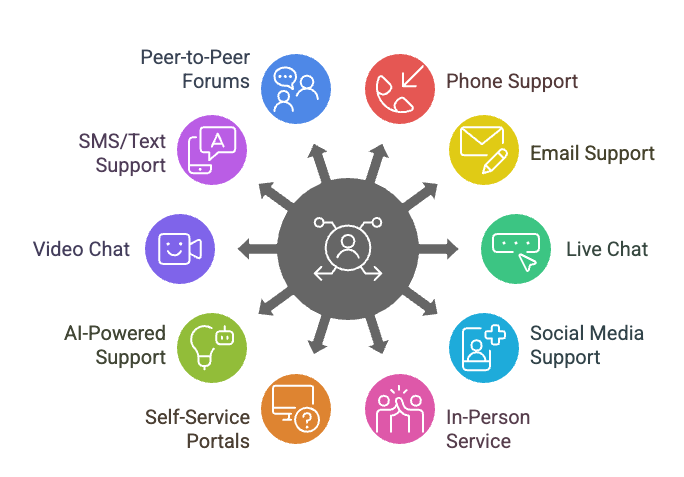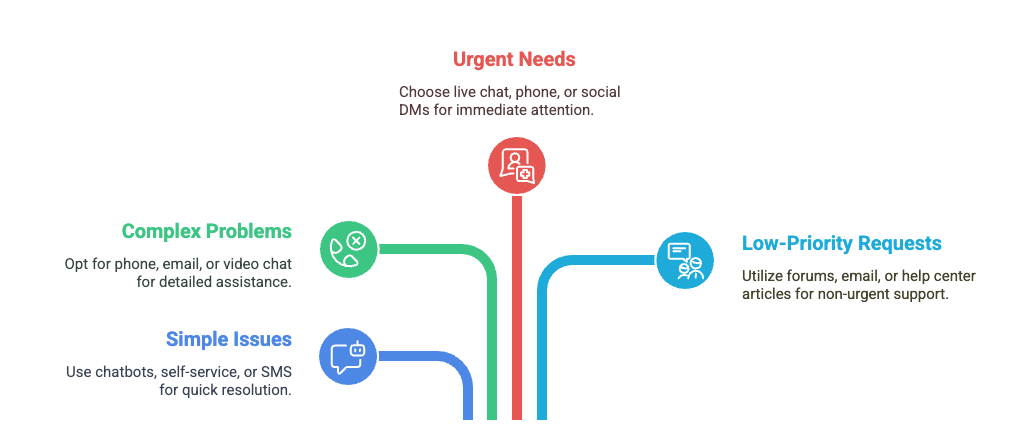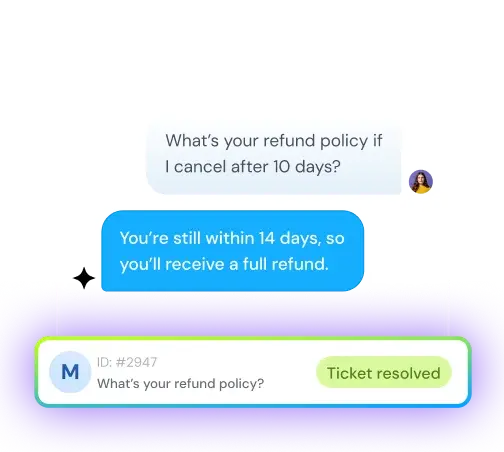10 Different types of customer service channels that drive sales in 2025
Sneha Arunachalam
Jun 03, 2025

Let’s face it — the different types of customer service you offer can either grow your business or quietly stall it.
Remember when a phone line and a polite voice were all you needed? Those days are gone.
Today, customers expect options. Around 40% want to help themselves with self-service tools. About 36% still prefer speaking to someone over the phone, and 33% lean toward live chat.
These preferences have shifted a lot over time, especially as new technology and customer expectations evolve — and they keep changing. The truth? No one-size-fits-all approach works anymore. In fact, 81% of customers now expect brands to offer different kinds of customer service, not just the usual suspects.
That’s what this blog is all about — helping you understand the different types of customer service available in 2025, how they work, and when to use each one so you can meet your customers where they are.
What do we mean by different types of customer service?
Today’s customer service is way more than someone answering the phone. It’s a network of channels that let people connect with businesses in whatever way feels most comfortable.
So, what exactly are the different types of customer service? Think of them as tools in a toolbox — some are built for speed, others for complexity, and each one fits a different kind of customer need.

Here’s a quick overview:
- Phone support – Still the go-to for urgent or sensitive issues
- Email support – Best for detailed, documented conversations
- Live chat – Instant help while customers are already browsing
- Social media – Support where people are already scrolling
- In-person service – High-touch help that builds loyalty
- Self-service portals – For customers who prefer to solve things themselves
- AI-powered support – Fast, smart, always-on assistance
- Video chat – Adds a human face for technical or emotional issues
- SMS/text – Convenient, real-time help in your customer’s pocket
- Peer-to-peer forums – Let your customers help each other
Each of these represents a different kind of customer service, and combining them smartly is the key to keeping customers happy.
How customer service has evolved in 2025
Here’s what’s new — and why it matters:
- Digital-first is the default. It’s no longer a bonus — it’s expected.
- Omnichannel is the norm. Customers want to start in chat, continue in email, and finish on the phone — seamlessly.
- Generative AI is transforming support roles, handling routine stuff so humans can focus on real connection.
- Proactive support now stops problems before they start, thanks to predictive analytics.
- Personalization has gone from “nice touch” to table stakes.
- And most importantly: human connection still matters — maybe more than ever.
Even with all the tech, the best different customer service channels are still the ones that make customers feel heard and valued.
10 Different types of customer service (detailed breakdown)
Let’s break down the most effective different types of customer service businesses are using in 2025 — and when each one really shines.
1. Phone support
- Good old-fashioned phone calls are still going strong. When something feels urgent or emotional, most people still want to talk to a real human.
- It’s perfect for high-stakes or sensitive situations
- But it only works if your team’s fast and empathetic — people can hear frustration
2. Email support
- Sometimes, people just want to explain everything in one go and get a well-thought-out reply — no back-and-forth.
- It works best for detailed or less-urgent questions
- Bonus: It leaves a nice paper trail for both sides
3. Live chat
- Live chat is kind of the sweet spot — instant help without picking up the phone. Plus, it’s right there while customers are already on your site.
- Over half of consumers say they prefer businesses with live chat
- It’s great for multitasking (on both ends)
- Also plays well with automation, like chatbots and canned responses
4. Social media support
- People are already on Instagram, Facebook, X (Twitter), and LinkedIn — so when something goes wrong, that’s often where they vent first.
- It’s fast and super public, which makes transparency important
- And if you handle it right, it can actually turn a complaint into a win
5. In-person support
- This one’s not dead — far from it. In industries like retail, tech, or luxury services, nothing beats showing up in person.
- Great for hands-on help like product demos or repairs
- It’s pricier to maintain, but the loyalty it builds? Worth it
- Especially effective for first-time buyers or big-ticket customers
6. Self-service portals
- More and more people just want to figure things out on their own. A good help center, FAQ, or knowledge base can do wonders.
- Works great for common or repeat questions
- And customers love being able to get answers instantly — no wait
7. AI and automated support
- This is where things get futuristic. Smart bots, voice assistants, and auto-routing are changing the game.
- Helps answer basic questions fast, and hands off complex ones to humans
- Done well, it keeps costs down and response times short
8. Video chat support
- Sometimes, especially for technical or emotional issues, seeing someone’s face changes everything.
- Adds clarity when things are complicated
- Makes the whole experience feel more personal
- And customers tend to walk away more confident in the solution
9. SMS/text support
- Quick, easy, and super effective. Most people would rather text than wait on hold these days
- It’s perfect for updates, simple questions, or appointment reminders
10. Peer-to-peer forums
- If you’ve got a loyal customer base, let them help each other. It builds community and takes pressure off your team.
- Customers often answer questions faster than your support team can
- Creates a living knowledge base that others can search
- And it shows you what your customers are really thinking about
These different types of customer service aren’t just about options — they’re about giving people control over how they want to interact with your brand. When you get the mix right, it can completely change how customers experience your business.
When to use each type of customer service

Not every question needs a call. Here’s a quick guide
- Simple issues: Use chatbots, self-service, or SMS
- Complex problems: Phone, email, or video chat work best
- Urgent needs: Go with live chat, phone, or social DMs
- Low-priority requests: Forums, email, or help center articles
Matching the right different kinds of customer service to the situation is what separates great experiences from frustrating ones.
Age and regional preferences matter too
Not all customers want the same thing. Here's what I’ve seen based on data:
- Gen Z & Millennials: Love chat, messaging apps, and avoiding phone calls at all costs
- Gen X & Boomers: Prefer email and phone — they value clear, human contact
- Regionally: Preferences vary. Brazil favors WhatsApp. In Japan, formal email still dominates.
This is why having a mix of different types of customer service — all connected — is the safest bet.
Why omnichannel is the future
Customers don’t think in “channels.” They just want help.
Omnichannel means giving customers that help — however and wherever they reach out — with zero friction. If someone starts on your website chat and ends up on the phone, your team already knows the history.
Why it works:
- Consistent, seamless service
- Happier, more efficient agents
- Smart data that improves decisions
- Lower costs with better outcomes
Tools to manage it all
Handling many different customer service channels doesn't have to be messy. Here’s what helps:
- Cloud contact centers with CRM integration
- Smart routing and automation tools
- AI-powered reporting
- Language translation
- One unified inbox for your team
That’s how you keep everything connected — and avoid chaos.
What's next? future trends in customer service
Looking ahead, here’s where support is going in 2025 (and beyond):
- AI everywhere – From summarizing chats to spotting issues before they happen
- In-product help – Support is baked right into apps and tools
- Hyper-personalization – Every message tailored based on real behavior
- Emotion-aware AI – Yep, your chatbot will soon know when someone’s frustrated
No matter what changes, the smartest businesses will keep refining how they use the different types of customer service to meet customer needs — and exceed them.
Final thoughts
To win in 2025, it's not enough to just offer support — you need the right different types of customer service, working in sync. Some tools are best for quick fixes. Others are built for deep conversations. But when they’re combined in a way that feels seamless, magic happens.
So here’s your next step: audit your support channels. Not just what you offer — but how well they’re working together. That’s how you build real loyalty.
Because in the end, businesses that adapt, stay human, and offer different kinds of customer service the right way are the ones that win.
Quick Summary: 10 Different Types Of Customer Service Channels in 2025
The different types of customer service you offer can make or break your business growth. Gone are the days when a simple phone line sufficed—today's customers demand variety and convenience.
- 10 Service Channels: Phone support, email, live chat, social media, in-person service, self-service portals, AI automation, video chat, SMS, and peer-to-peer forums
- Digital-First Approach: Customer expectations have shifted to expect seamless digital experiences as the default
- Omnichannel Integration: Customers want to start conversations in one channel and continue in another without friction
- AI Transformation: Generative AI handles routine tasks while humans focus on complex, emotional connections
- Proactive Support: Predictive analytics help prevent problems before they occur
- Generational Preferences: Gen Z/Millennials prefer chat and messaging, while Gen X/Boomers favor email and phone
Success in 2025 requires offering different types of customer service that work seamlessly together. Each channel serves specific needs—some handle quick fixes, while others support complex conversations. The winning strategy is to audit your support channels and ensure they integrate smoothly. Businesses that adapt, stay human, and strategically implement different types of customer service will build lasting customer loyalty and drive sustainable growth.
Frequently Asked Questions
If you're running a small business, the smartest move is to start with self-service — things like a solid FAQ page, help articles, or a knowledge base. It takes a little effort upfront, but once it’s live, it can handle hundreds of questions without adding to your workload or cost. For live support, chat is usually more budget-friendly than phone calls because your team can juggle multiple conversations at once. A good starting combo? Self-service for the everyday stuff and one real-time channel (like chat or phone) for the trickier questions. You can always scale from there as you grow.
The best way to find out? Just ask. A short survey or feedback form can give you real insight into how your customers want to connect. You can also watch the data—see which channels people use most, what times they reach out, and what kind of issues they’re having. Keep in mind that preferences often depend on who your audience is. Younger customers might lean into chat, DMs, or even texting. Older folks might still feel more comfortable with phone calls or email. Start by offering 2–4 core channels, then adjust based on real usage and satisfaction scores. Let your customers guide the strategy.
Not at all. AI isn’t here to replace human support — it’s here to support it. Think of it this way: AI and chatbots are great at handling quick, repetitive questions, like order tracking or password resets. That frees up your human agents to focus on the stuff AI just can’t do — like solving complex problems, handling emotional situations, or offering a personal touch.The best setup? A blend. Let AI take care of the routine, and let your team shine where it really matters. It’s about working smarter, not replacing anyone.
You don’t need a dozen channels overnight. The key is to start small and build thoughtfully. First, make sure your existing tools are connected—especially your CRM—so your team has the full picture of every customer, no matter where they reach out. Next, focus on syncing your top two channels (say, email and phone, or chat and social media). Tools that offer shared inboxes or conversation histories across platforms can make a huge difference. You can also automate basic tasks, like routing requests or sending follow-ups, to save time and don’t forget your team — consistent training across channels is more important than adding new ones too soon. Quality over quantity always wins.
Here are a few key metrics to watch:
- First response time – How fast are you getting back to people?
- Resolution time – How long does it take to actually solve the issue?
- First contact resolution – Can you fix it in one go, or does it take multiple tries?
- Channel switching rate – Are customers bouncing from chat to phone to email just to get help?
- Cost per resolution – How much does each successful interaction actually cost you?
- Self-service success rate – Are people finding answers on their own, or still needing help afterward?
